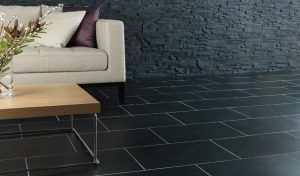With so many flooring options to choose from, it really comes down to your own personal taste and style. Here’s our guide to the types of materials available, together with maintenance levels and costs, to help you choose the right flooring for your dream home.
Solid Wood Flooring:
Parquet flooring is where individual pieces of wood are glued to a concrete sub floor. They connect with tongue and groove to fill a room with a herringbone pattern. Parquet flooring offers a high quality finish, but requires professional laying, filling any gaps and sanding before the final varnish. Solid wood floors also require buffing every 3 – 5 years depending on wear and tear.
Parquet floors are long lasting and durable, but they can also buckle and bow with humidity and sometimes gapping occurs, leaving excessive spaces between planks. Refinishing can often help. The floor is sanded using a very fine sander, which removes the finish from the older wood and smooths out the surface.
So while solid wooden flooring can be one of the more expensive options, and is best placed in an environment where you have a constant temperature and humidity, it does offer a beautiful looking finish.
Engineered Wood Flooring:
Engineered wood flooring is where a floorboard, consisting of three or four layers of wood, has each layer glued at right angles to the next, which creates a plank around 14mm thick. Layering the wood like this creates durability and strength. The final top layer is made from a real wood veneer and allows the flooring to be sanded and treated in the event of scuffs, damage or wear and tear.
Engineered wood flooring will withstand much more humidity than solid wood floors, though it’s not recommended for use where it might be exposed to water or high humidity. It’s cheaper than solid wood flooring and will cost you less time and money on upkeep and maintenance. Though it’s a little more expensive than laminate, it’s much more aesthetically pleasing.
Stone Flooring:
There are several different types of natural stone flooring. The most popular are granite, slate, stone, marble and travertine. They offer a strong, durable and resilient floor, though whether they’re porous or non-porous stone, both types require treatment and maintenance.
Sealing the stone offers protection from staining, though you’ll still need to mop up any spills to avoid permanent staining. It’s important to remember that chemical cleaners should never be used on stone floors as they can potentially damage them, and dry mopping is recommended for day-to-day care.
Stone flooring can be expensive and you will need expert advice and experienced professionals for installation. It’s perfect for kitchens and bathrooms, but needs to be properly laid so that less breakage, cracks, splits, slipping or unevenness occurs.
Non-porcelain Ceramic Tiles & Porcelain Ceramic Tiles:
Both types of ceramic tiles offer great durability and strength, but porcelain ceramic flooring is the most durable of the two. While it might be harder to work with, and will require professionals to install, porcelain ceramic flooring has a natural stain resistance, minimal water absorption and a solid looking colour to its finish. Formed from red, white or brown clay and other minerals, it has a glass-like appearance, and different kiln temperatures give each tile its own unique finish.
Non-porcelain ceramic tiles are a great alternative if you’ve got budget restrictions as they’re one of the most economic alternatives to many of the types of flooring available. Plus, they’re not as high maintenance as other flooring types.
We recommend ceramic tiles for use in areas prone to water exposure, like kitchens and bathrooms.
Carpet:
Carpet is one of the softest flooring materials available and there are a variety of synthetic and natural fibres available. The four most common materials are nylon, polyester, polypropylene and wool.
Nylon carpets are very soft, durable and resistant to stains and they’re the most popular carpet material.
Polyester fibres are prized because they can hold their colour and don’t fade much over time. The drawback is that these fibres can flatten with repeated exposure to weight, so it’s not a good choice for high traffic areas.
Polypropylene carpets are almost as soft as nylon. They are extremely resilient to stains, mildew and shedding too.
Wool carpet is the softest fibre you can buy and it’s a luxurious, long lasting material. Unfortunately, low-grade wool is more susceptible to staining and high-grade wool is incredibly expensive. Some manufacturers combine wool with synthetic fibres to create a carpet with the best benefits of both.
